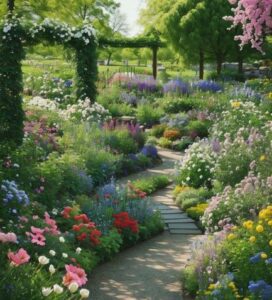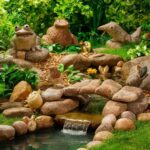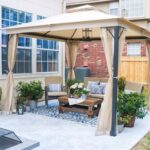Want to create a colorful garden in your backyard? Here’s how you can do it:
- Choose a variety of wildflowers: Pick flowers like daisies, sunflowers, and zinnias that bloom in different colors.
- Plant the flowers in a sunny spot. Make sure your garden gets plenty of sunlight for the flowers to thrive.
- Water the plants regularly. Keep your garden hydrated by watering the flowers when the soil feels dry.
- Add some mulch. Mulch helps retain moisture in the soil and keeps weeds at bay.
- Watch out for pests: Keep an eye out for bugs that might harm your flowers and take action to protect them.
By following these steps, you can create a beautiful and colorful wildflower garden right in your own backyard.
Benefits of a Wildflower Garden
Cultivating a wildflower garden in your backyard has many benefits. Wildflowers attract bees and butterflies, adding beauty and life to your garden. They’re easy to maintain, so you can enjoy colorful blooms without a lot of work.
Wildflowers can grow in different types of soil and are drought-tolerant, which means you can save water while still having a thriving garden. They also support biodiversity, which is good for the environment.
In simple terms, planting a wildflower garden is a great way to create a beautiful, low-maintenance garden that helps pollinators and the ecosystem.
Choosing the Right Wildflowers
If you want a colorful wildflower garden in your backyard, choose native wildflowers that suit your area’s weather and soil. Pick flowers that bloom at different times so your garden stays lively all year.
Native wildflowers help local ecosystems and attract wildlife like bees and butterflies. Consider their height and colors for a varied landscape. Black-eyed Susans, California Poppies, and Purple Coneflowers are great choices. They bloom in different seasons and attract birds, bees, and butterflies.
Sunflowers and Lupines are good options too. Create a beautiful and wildlife-friendly backyard with the right wildflowers.
Designing Your Wildflower Garden
When planning a wildflower garden, check the sunlight and soil to make sure your flowers will grow well. Try planting different wildflowers of varying heights and colors to make your garden look interesting. Think about when each flower will bloom so you can enjoy a colorful display all year round. Using native wildflowers will help local wildlife and support the environment.
To make your garden even better, create paths through the wildflower area. These paths will make it easier to take care of your garden and let you get close to the beautiful flowers. By following these tips, you can design a wildflower garden that looks great and helps the environment and local wildlife.
Planting and Maintenance Tips
To keep your wildflower garden healthy:
Water deeply but less often for strong roots and drought resistance.
Remove dead flowers to promote new blooms.
Use natural weed control methods to protect your plants and wildlife.
Let seeds spread naturally for diversity.
Divide overcrowded plants for better growth.
A well-kept garden isn’t just pretty but also a haven for bees and animals.
Attracting Pollinators and Wildlife
To attract bees, butterflies, and other helpful bugs to your backyard wildflower garden, choose plants that they like.
Make cozy homes with food and shelter for birds, bugs, and small animals.
Adding water features not only looks nice but also helps all kinds of wildlife thrive in your garden.
Pollinator-Friendly Plant Selection
To attract bees, butterflies, and other pollinators to your backyard, plant native wildflowers like Bee Balm and Purple Coneflowers. These flowers not only look pretty but also help different insects. Choose flowers like Black-eyed Susans and Salvia that have lots of nectar to feed the pollinators.
Mix up colors and shapes in your garden to attract a variety of pollinator species. Don’t forget to include host plants like Milkweed for butterflies to complete their life cycle. Avoid using pesticides to keep these important pollinators safe and create a natural and healthy environment.
Providing Habitat for Wildlife
To make your backyard wildlife-friendly, consider the following elements:
- Add native wildflowers that attract pollinators like bees and butterflies.
- Include natural stone for hiding spots for small animals.
- Incorporate a water feature for birds and butterflies to drink from.
- Plant morning glory flowers to attract hummingbirds and butterflies with their bright colors.

Enjoying Your Wildflower Oasis
Create a peaceful garden with vibrant wildflowers. Add seating areas for relaxation and enjoyment of the colorful blooms.
Invite family and friends to share the beauty of your garden. Attract birds with feeders and baths to enhance the charm of your oasis.
Install wind chimes or outdoor speakers for a soothing atmosphere. Design pathways through the wildflowers for exploration and appreciation of plant life.
Consider adding a water feature like a birdbath or pond to attract wildlife and create a tranquil focal point. Enjoy the serenity and connection with nature in your beautiful garden.
Frequently Asked Questions
What Are the Disadvantages of a Wildflower Meadow?
Creating a wildflower meadow needs a lot of work. You must remove weeds often and make sure the soil has enough nutrients. It may take time and energy, but the beautiful, flower-filled area you create will be worth it.
How Do You Make an Oasis Garden?
To create an oasis garden, you need soil, water, native plants, and pollinators. Add colors, textures, and scents for a beautiful retreat. Use stones and water features for a calm vibe. Include plants that thrive in your climate.
How Do I Turn My Backyard Into a Wildflower Garden?
To turn your backyard into a wildflower garden, choose native plants, prepare the soil, and plant seeds in the spring or fall. Water deeply, but not too often. Look for bright colors and local plants to help the environment. You’ll bring in bees and butterflies for a healthy garden.
Are wildflower gardens hard to maintain?
Wildflower gardens are easy to maintain. You just need to deadhead old flowers, pull out weeds by hand (no chemicals), and let seeds spread on their own. If plants are too crowded, divide them to help them grow better and support different kinds of plants.
Conclusion
After making your backyard wildflower garden, enjoy the beauty and liveliness it brings.
Native wildflowers, good design, and proper care have created a colorful oasis that enhances your backyard’s look and supports wildlife.
Watch the bees, butterflies, and birds that will visit your garden, and enjoy the natural beauty around you.











